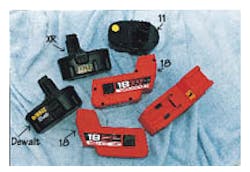Understand 18-volt battery technology and alternative power supplies.
Subject: Cordless Reciprocating Saws, Part 2
Topic: Power supply for cordless reciprocationg saws
Objective: Understand 18-volt battery technology and alternative power supplies
Task: Review 18-volt battery technology and explore capabilities of various power supplies for cordless reciprocating saws.
Part 2 of our series on cordless reciprocating saws focuses on the 18-volt battery, the saw’s primary power source. We’ll look inside a battery to understand how they work and address ways you can get the most out of your 18-volt rechargeable batteries.
The 18-Volt Rechargeable Battery
The standard power source for both the Milwaukee and DeWalt cordless reciprocating saws is the individual 18-volt battery. The battery consists of individual cells hooked together in series to provide the required 18 volts of power. The plastic battery case contains the connection terminals and a means to secure and release the battery from the handle of the saw.
All rechargeable 18-volt reciprocating saw batteries that DeWalt and Milwaukee sell are manufactured by Panasonic or Sanyo and are sold under the Milwaukee and DeWalt label.
The 18-volt rechargeable batteries are called "NiCads" because the material inside them that accepts and stores the electrical charge is nickel cadmium, a precious metal. Soon, manufacturers will introduce 18-volt rechargeable batteries made of nickel metal hydride, NiMH, a different and better performing metal. This new generation of reciprocating saw batteries will be capable of powering tools 55% to 100% longer than the current NiCads.
In 1998, DeWalt upgraded its 18-volt battery packs to assure better performance. All of DeWalt’s upgraded 18-volt batteries are marked with a yellow dot on the top of the pack. If you own an older battery pack, DeWalt will install this upgrade to your unit free of charge. Call 1-800-4-DeWalt for details.
How Do Reciprocating Saw Batteries Differ From Typical Rechargeable Batteries?
There are many myths and misconceptions about reciprocating saw batteries among fire and rescue personnel. Our greatest fire service experience with NiCads is as a power source for our portable radios or pagers.
As firefighters, our most fundamental belief about rechargeable NiCad batteries is that they develop a “memory”. Fire station discussions also include warnings of the “dangers” of recharging a partially used battery and war stories of how batteries left on chargers will get ?lazy? and not hold their charge when really needed. All these statements and others you may have heard about rechargeable NiCad batteries DO NOT apply to batteries used in cordless reciprocating saws.
Radio and pager NiCad batteries are not used in the same manner that we use 18-volt saw batteries. Similar to a marathon runner, portable radio or pager batteries discharge their energy slowly over a long period. The battery discharges a slow, steady current throughout the 12 or 14 hours that the unit is turned on.
Reciprocating saw batteries, however, are more like sprinters than marathoners. These batteries are used hard and fast during the brief moments of a rescue and undergo maximum draw for just a brief period. The current draw is so hard and so fast that the battery will actually heat up, sometimes significantly, as its energy is drained. Because of this inherently different way of drawing power, 18-volt reciprocating saw batteries WILL NOT develop a NiCad memory. In fact, the best place for a reciprocating saw battery is on a charger that is plugged into a power source.
A battery not in a charger unit loses 5% of its energy each day due to normal deterioration. When a battery is first placed on a DeWalt charger, the charging process begins with a rapid first stage charge. Initial charging of the DeWalt 1.7-amp/hour XR2 battery pack or the Milwaukee 2.4-amp/hour battery takes between 50 and 75 minutes. The DeWalt charger then transitions into a second charge mode that “tops off” the cells of the 18-volt battery. After 16 hours on the charger, a third stage that DeWalt calls its “maintenance stage” kicks in to trickle charge all cells to the fully ready mode. An 18-volt battery pack will eventually lose all its charge if left in a charger that is not plugged into an appropriate power source.
A DeWalt exclusive is a new battery charger unit with a deep discharge feature incorporated into its design. This process, which DeWalt recommends once every five times you charge battery, takes approximately six hours to recondition the battery fully.
Both brands of charger units have LED lights that signal the status of the battery. DeWalt signals charging with a blinking red light and fully charged status with a steady red light. Milwaukee uses a steady green light to indicate charging and a blinking green to signal the end of the charging process.
Immediately after heavy saw use, a battery will be warm, even hot to the touch. This is normal due to the battery discharging its energy. Both charger units have sensors that measure battery internal temperatures and shut down the charging process if the battery is too hot. When the DeWalt charger for example, receives a battery that is internally hot, it automatically starts its “hot pack” charging delay. This suspends charging until the battery has cooled internally. After cooling, the charger automatically switches to the “Pack Charging” mode.
Longest life and best performance can be obtained when the battery pack is charged in temperatures between 65 and 75 degrees Fahrenheit. Do not charge a battery in an environment that is hotter that 105F or colder than 40F.
Because chargers protect themselves from hot batteries, it is not practical for departments to expect to use a battery and immediately recharge it for use again at the same rescue scene. Batteries must first cool - during our endurance tests, this took at least 15 minutes. Charging took another 50 minutes. If you’re still doing rescue work after 65 minutes of on-scene time, either you haven’t trained at all, you made some serious mistakes or the rescue challenges are so great that you are into extended operations. Fortunately, extended-duration incidents are not the norm.
DeWalt also manufactures a DC-powered battery charger with a cigarette lighter socket adapter. The electronics of this special unit will fully charge an 18-volt reciprocating saw battery using a fire or rescue vehicle’s 12-volt electrical system. The charger unit can also be permanently hard-wired into a vehicle’s electrical system. It is not harmful to the battery to be left in this DC charger when not in use. Frequent running and shutting down of the vehicle will not damage the 18-volt battery. In quarters, an electrical shore line should be provided to trickle charge the system, maintaining the saw battery at full capacity.
With a DC charger on a vehicle, do not charge more than two battery packs without running the vehicle’s engine. With the engine shutoff, the vehicle’s battery will be drained. If you use the cigarette lighter adapter, disconnect the charger from the cigarette lighter socket when the vehicle is not in use. This will prevent the vehicle’s battery from discharging while the engine is off.
Portable Power Source Problems
When the DeWalt charger is used with some portable power sources such as a generator or inverter that converts DC to AC, the charger may temporarily suspend operation. It will flash its red LED light with two fast blinks followed by a pause. This indicates that there is a problem with the power source and that its generation of power is out of acceptable limits.
Vulnerability To Moisture
During one session of field testing, this author found out the hard way that both brands of battery chargers are extremely vulnerable to destruction by moisture.
A brief rain shower sprinkled onto our extrication equipment and the charger units we had set up. Almost instantly, both chargers snapped, crackled and popped as they shorted out. The Milwaukee unit put out more white smoke than a smoke machine at a training academy. The water was instant death for these units. Do not expose 18 volt charger units to moisture from any source, including rain, snow or hose sprays. Keep the charger units in protected environments.
Likewise, avoid placing the charger or battery pack in an unusually warm or hot environment. Exposure to direct sunlight when recharging a battery, for example, will heat the battery just taken off the saw. The charger won’t allow it to charge until it has cooled, thus delaying the recharge process.
Battery Management For Best Performance
We mentioned earlier that reciprocating saw 18-volt batteries, unlike other NiCads you are accustomed to, do not develop a memory. Our testing over almost two years has proven this to be true. Another myth that must be put to rest is that “getting the last drop of juice” out of the battery is a good thing to do.
Fire officers and rescue instructors may claim that running a battery until it is completely exhausted and the saw stops operation is the only way to get the full power from the battery. For an 18-volt battery, completely draining it can permanently damage it.
An 18-volt rechargeable battery should be removed from the saw as soon as it slows and fails to produce sufficient power for the cutting job. Do not continue to run a battery until it is completely drained. Pushing it beyond the point of its useful work will permanently damage the battery by causing the internal cells to reverse their polarity. The damaged cells will not accept a charge, significantly weakening the battery.
As soon as the saw slows significantly, consider the battery spent. Remove it and place it on a charger. Also contrary to popular fire service belief, you can and should charge a partially discharged battery pack at any time with no adverse effect on the battery. It will not develop a memory like the pager and portable radio batteries to which we have become so accustomed.
Ron Moore, a Firehouse contributing editor, is a battalion chief and the training officer for the McKinney, TX, Fire Department. He also authors a monthly online article in the Firehouse.com “MembersZone” and serves as the Forum Moderator for the extrication section of the Firehouse.com website. Moore can be contacted directly at [email protected].
Series Links:Part 1 | Part 2 | Part 3 | Part 4 | Part 5





